On Humanness and the Expansion of The Body
Geumhyung Jeong
Mousonturm Frankfurt
Geumhyung Jeong
Mousonturm Frankfurt
17–02–2021
by Sarah Reva Mohr
by Sarah Reva Mohr
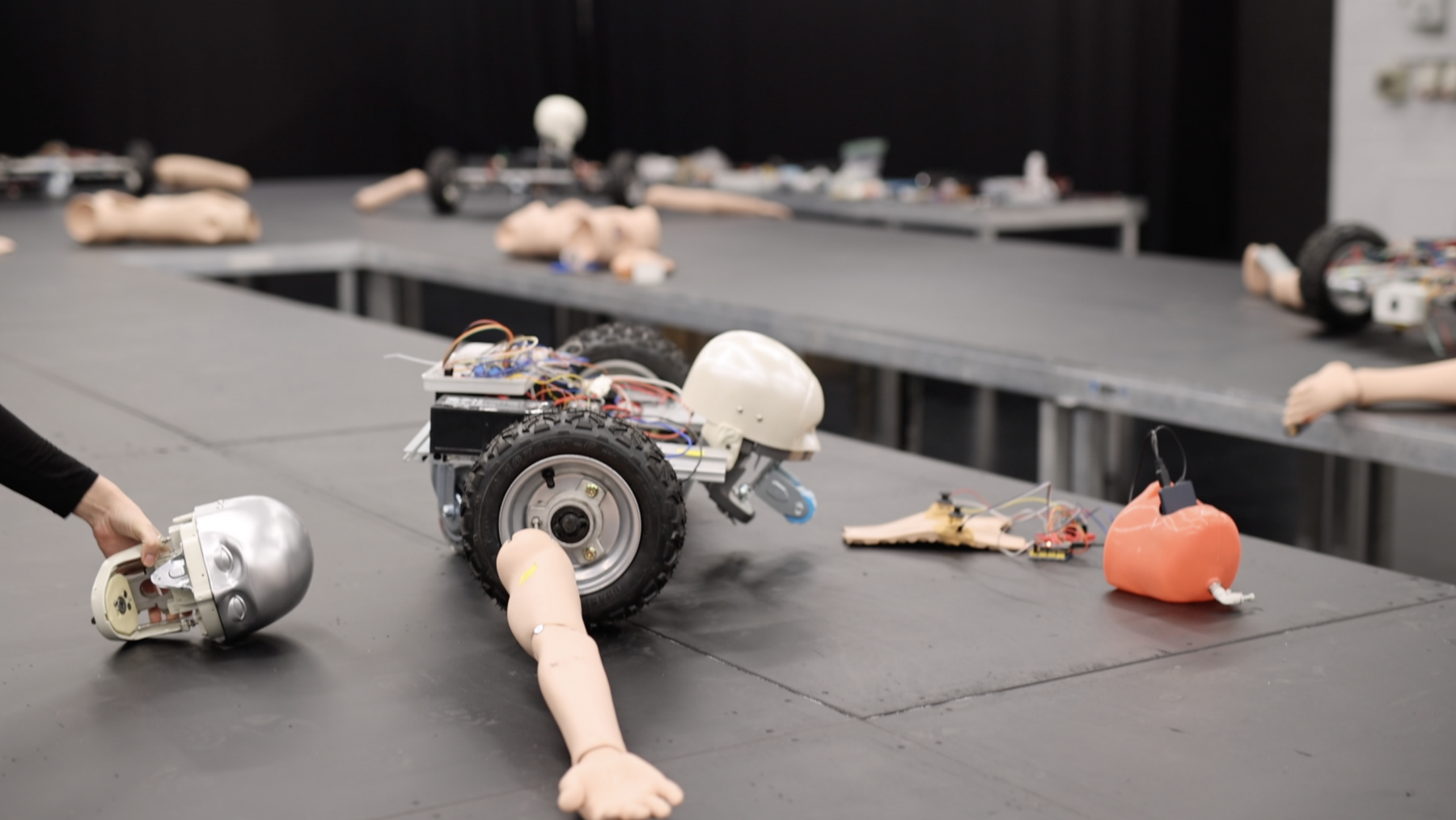
Geumhyung Jeong, TEST RUN, 2021. Courtesy: the artist and Mousonturm, Frankfurt; photograph: Jörg Baumann
Flexibility and Isolation – On humanness and the expansion of the body
Several robot sculptures lie stretched out on large podiums, exposing their technical parts like organs, both solid and somehow fragile in their appearance. ‘Flexibility and isolation’, echos Geumhyung Jeong’s voice through the digital space like a mantra – impassive and distant as if it was computer-generated. We’re in the middle of a Test Run, a new production by the South Korean performance artist, in which engine and error noises determine the otherwise reduced soundscape. Symbolically referring to bodily ‘movements’, different body parts such as arms and legs are attached to engines and are set in motion by the artist – lifeless, almost inert. As they are being carried around, the ‘human’ attributes seem to be the engine’s slaves, her brief instructions let the camera turn in the direction of a certain robot before the engine starts howling. They don’t have names, only numbers. But what might indicate an unemotional encounter between the artist and her machines at first sight, appears to be more than that.
In Test Run, various synapses link important aspects of bodily inter-connectivity, asking if robots and humans are collaborators or opponents? Does humanness already begin where limbs or the attempts of a facial form become recognizable? The operation of the machines, the “touches” that happen between the performer and the objects are characterized by an intimacy that is exciting to observe as the artist’s “control” over circuits and boards could potentially collapse at any time. The performance articulates sensuality with and in-between machines. Jeong employs her hands and mouth to start and move the robots and after a certain time, it hardly seems to make a difference who sets whom in motion – whether human or machine, bodies merge into each other. What looks like a kiss of two robots is in fact a precisely choreographed movement that is always about to fail. Thus, a supposedly “tenderly” implied logic of touch, which may have only been completed as such in our minds, changes to a mode of movement characterized by technical inability and bumpy approach. The eroticism of circuits, control technology and buttons generates another form of body language that plays with co-existences, partly retraining dialogical skills in front of us, partly encouraging a philosophical reflection on bodily encounters while hierarchies are dissolving.
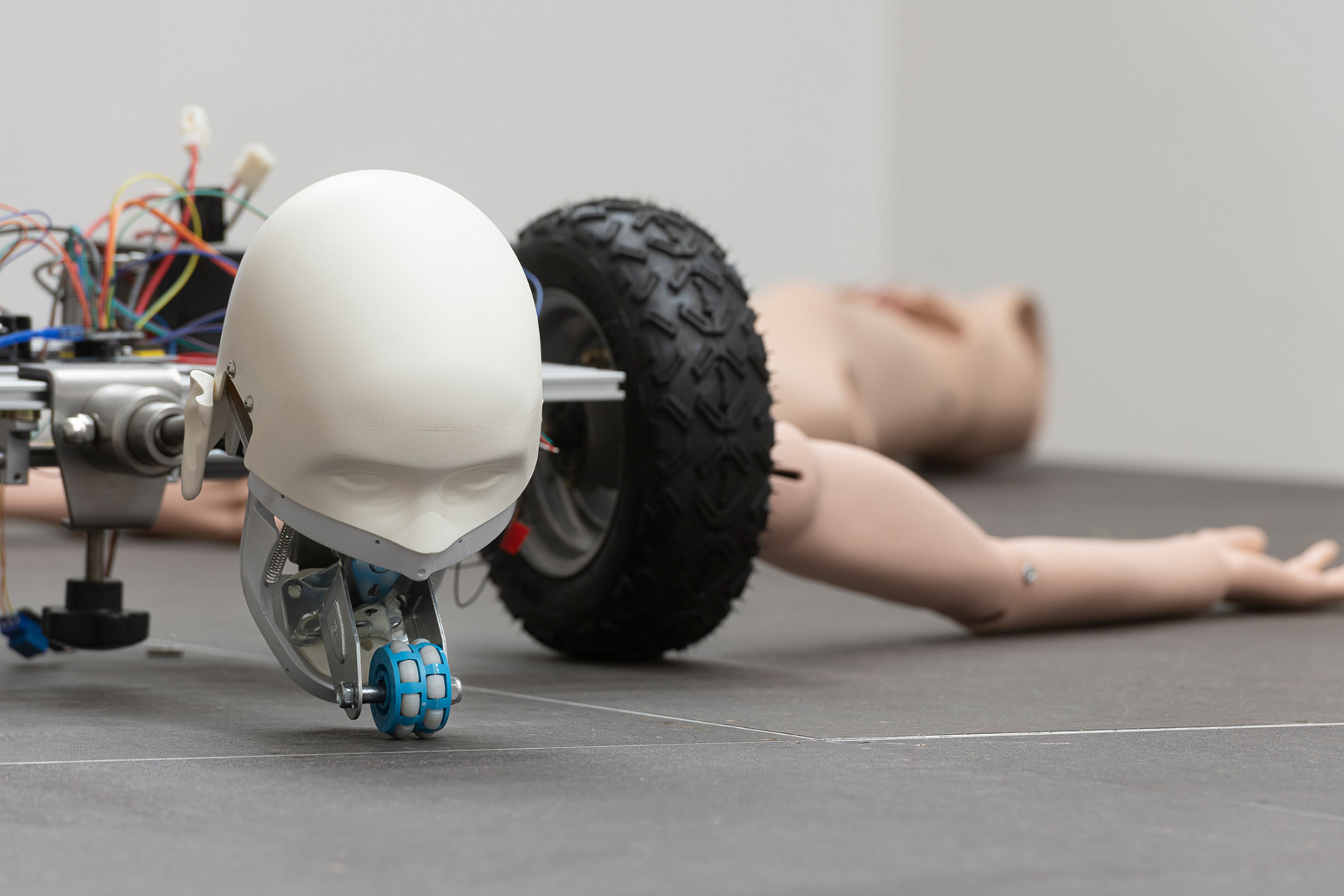
Geumhyung Jeong, TEST RUN, 2021. Courtesy: the artist and Mousonturm, Frankfurt; photograph: Jörg Baumann
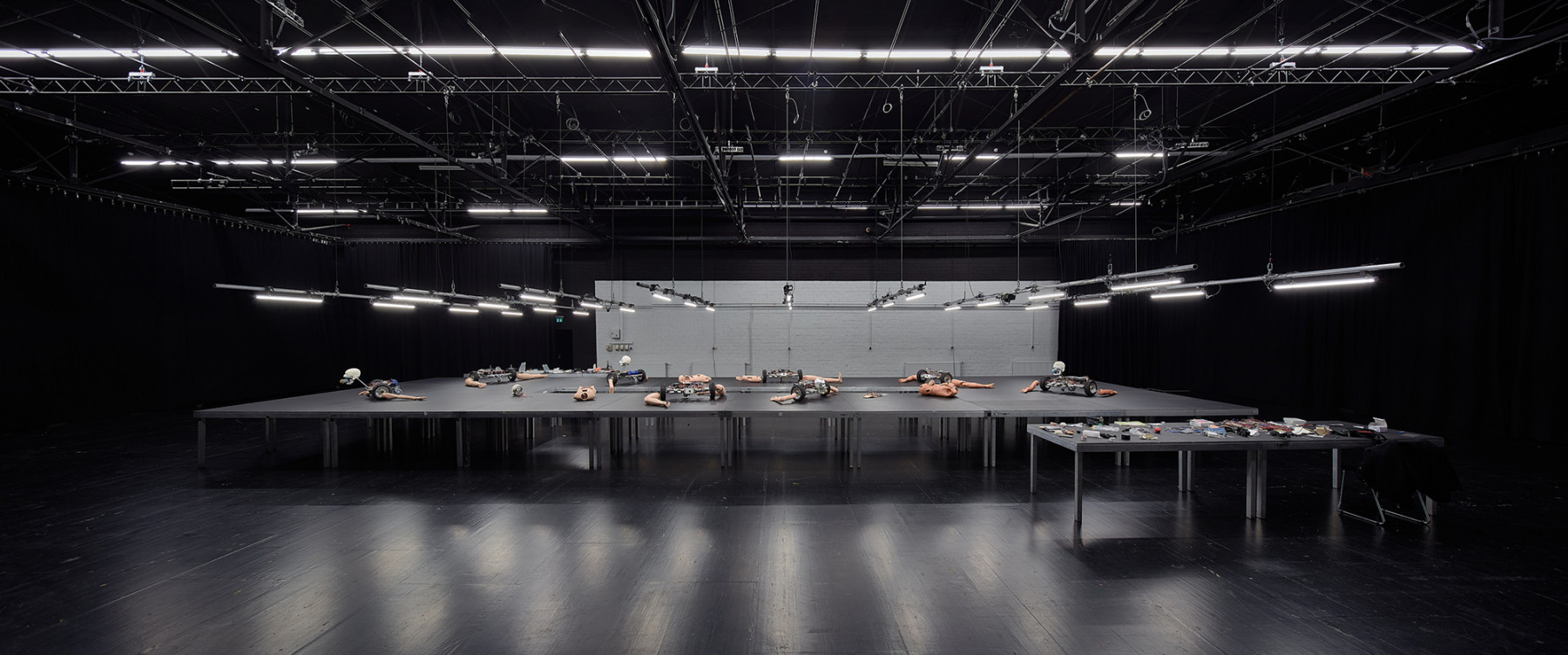
Geumhyung Jeong, TEST RUN, 2021. Courtesy: the artist and Mousonturm, Frankfurt; photograph: Jörg Baumann
“I need a flexible body”
This extensive performative part concludes a three-hour-long online presentation, which constantly switches from intense bodily physical encounters to technically adept and detail-oriented, almost analytical scenes. A human body, connecting and expanding its own realms through parts of machines is nothing new but challenges thoughts on where our body begins and where it ends – is our life also an ongoing test run?
The piece’s beginning is filled with browsing sequences through loads of internet footage, mostly tutorials or advertising of technical gadgets such as model helicopters or drones. Followed by a scene, in which the artist sets up a drone (which also carries a huge male head and a penis) for a test run, failing the attempt due to a broken wing. Viewers will never see the drone taking off. Her field of reference at this point is technology and its visual translation through media: whether in tutorials on the internet, in visuals or through music, she continuously tries to play off the inherently threatening-aggressive and also mostly masculine parts of technology showcasing.
Jeong opens up another narrative, in which she showcases past works and their redevelopments –diverse interactions with reanimation mannequins which are put into different settings. In the presentation, she is in a mode of self-archiving, while at the same time critically self-reflecting her own works, taking us with her to a review of performances which highlight moments of failure. She leaves it up to viewers how to deal with them by questioning if it’s also a matter of control and absolute obedience that needs to be discussed.
Through the course of the piece, we continuously dive into the world of medical technology, in which the protagonists remain reanimation and nursing dolls for the time being. The sterility of their material and the atmosphere of the numerous superimposed tutorials is counteracted by the confrontation of the artist’s human body and the mechanics of a dummy. The two bodies on screen – one “real”, the other artificial – challenge each other in their flexibility and vulnerability in different forms of expression.
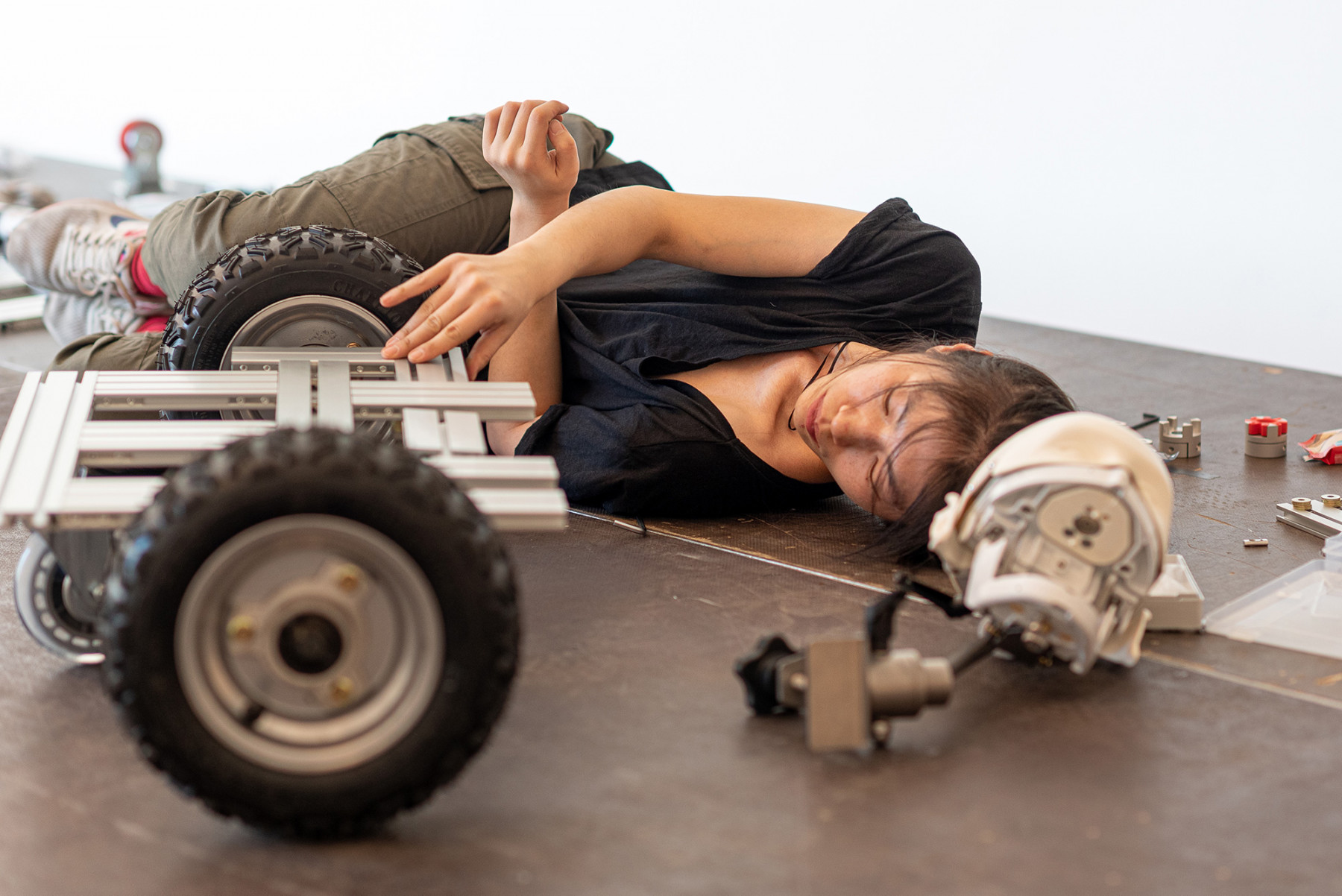
Geumhyung Jeong, TEST RUN, 2021. Courtesy: the artist and Mousonturm, Frankfurt; photograph: Jörg Baumann

Geumhyung Jeong, TEST RUN, 2021. Courtesy: the artist and Mousonturm, Frankfurt; photograph: Jörg Baumann
“I didn’t want to give any gender to the body – so it can be anybody.”
Unlike patients in need, Jeong interacts with those mannequins within her performative scenes, modifying them into carriers of actions contrary to their purpose, who may well appear autonomous – but they won’t be, since their “aliveness” always requires her input. Thus, the recorded performance in a tiled studio space becomes an experimental venue between input, output and the question of initiation, when a puppet hits the artist’s exposed buttocks with its hand. It is about testing bodily limits of both actors – the human and the artificially recreated –, who exhaustively sink into each other after their interaction. The effect is grotesque since it points to the fleeting interpersonal moment of the almost romantically tender relationship between them that contrasts the cold and hard studio environment. However, it’s the analytical, unemotional descriptive voice-over that swallows any hidden romantic depth, when she says: “... this mannequin’s flexibility was satisfying.”
A certain fascination for machines and their human avatars becomes evident in scenes, where specifics about technical and material backgrounds are shared: very long shots of details and technical translation require some patience of both, the artist and the viewer as they are exposed to the long journey of machine parts becoming a sculpture.
All comes down to the look behind the scenes of Jeong’s new production at Mousonturm – whose highlight is the actual “test run”, which is accompanied by camera with a constantly changing focus. The individual robot sculptures form a large, expansive apparatus where movements are transferred from one “body (part)” to the next, whether by remote control or direct touch of the robot’s control parts.
The length of the entire process and the performance could fill a cinematic documentary format. Honestly, I would have loved to sit in a movie theatre watching this, as the richness, the attention to detail and the extended consideration of her approach – informatively and atmospherically – could already fill such a space. For those who want to delve deeper into the artist’s previous performances and her way of working, this format is recommended. It is rare to get such a close insight into an artistic practice and the performative design simultaneously, the ambivalent world that opens up, moving in-between the synapses of body as material and materials becoming bodies.
Test Run captures a strange relationship between the artist and those dummies and robots. Their movements and the setting that surrounds them make them seem awkward, almost helpless, despite precisely choreographed arrangements. The reanimation and nursing mannequins as well as the robots, thus, open up important questions of dependency: who cares for whom? Who is useful to whom? These networks of relationships, peculiarly intimate, go far beyond mere use. Instead, they show that choreography is not exclusively a matter of human bodies moving in space: dependence and vulnerability are embedded in every type of body, human and non-human.
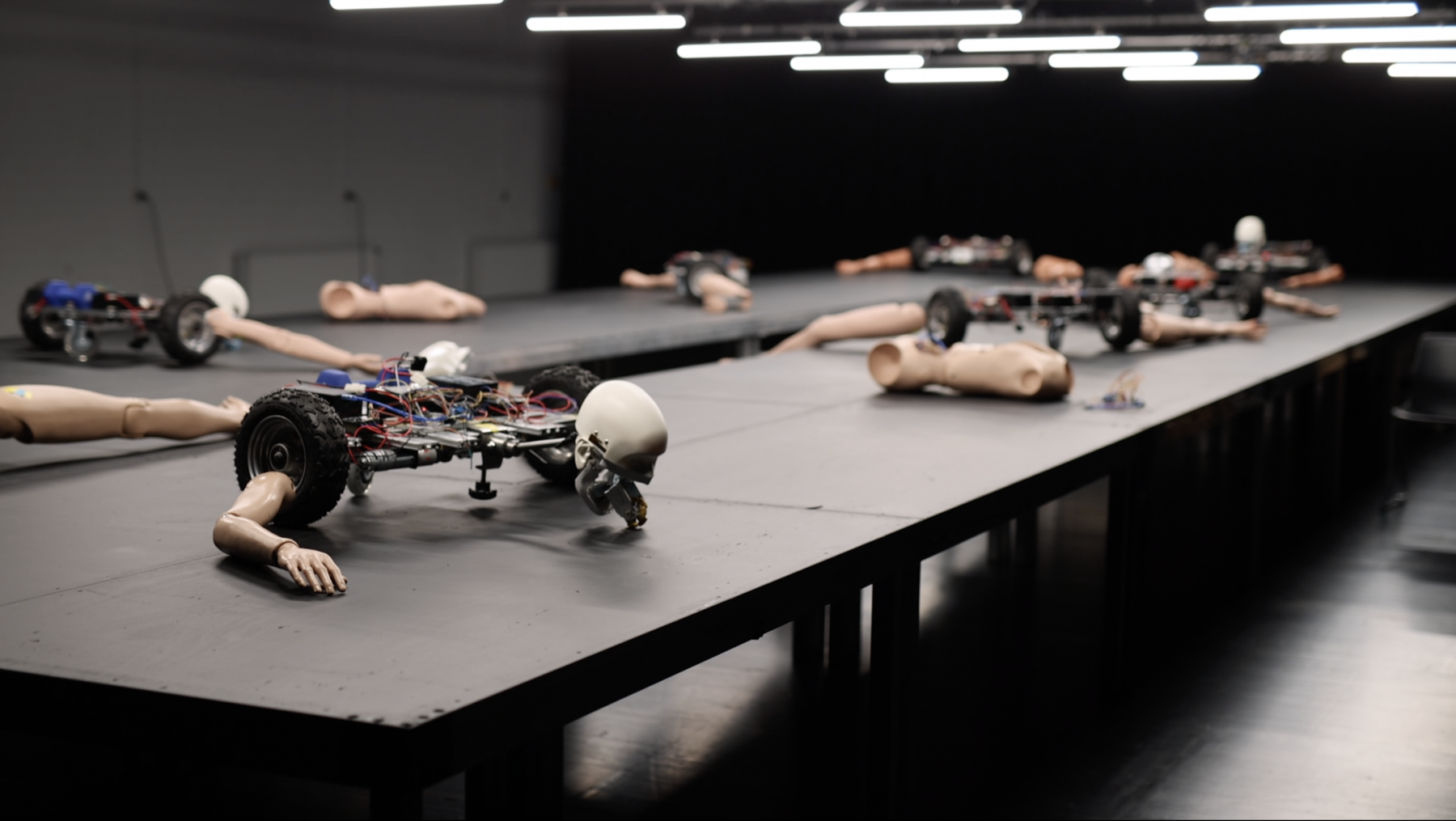
Geumhyung Jeong, TEST RUN, 2021. Courtesy: the artist and Mousonturm, Frankfurt; photograph: Jörg Baumann
Geumhyung Jeong – Test Run
10 - 17 February 2021
The performance can be viewed at Digitaler Mousonturm
10 - 17 February 2021
The performance can be viewed at Digitaler Mousonturm
Mousonturm
Waldschmidtstraße 4
60316 Frankfurt am Main
Waldschmidtstraße 4
60316 Frankfurt am Main